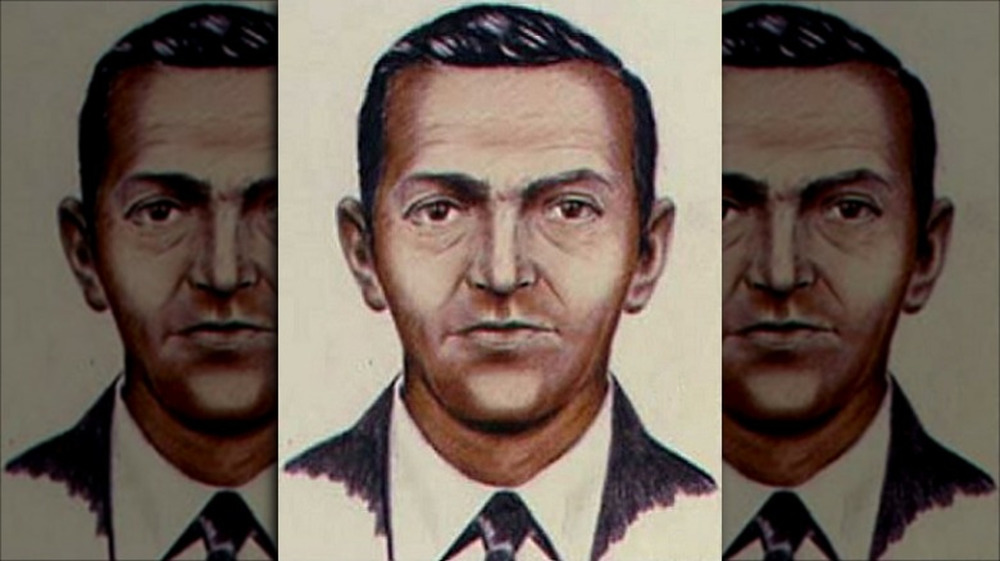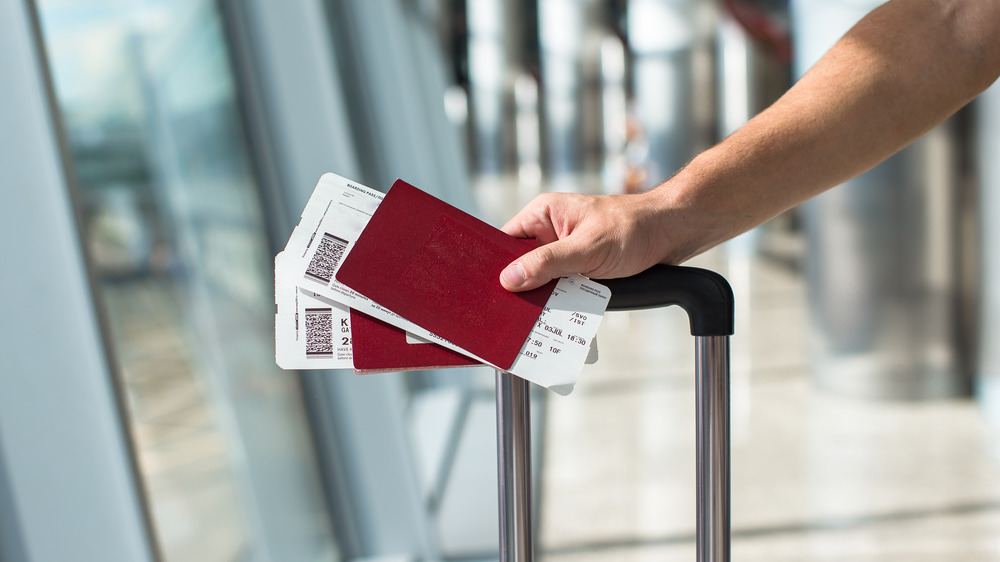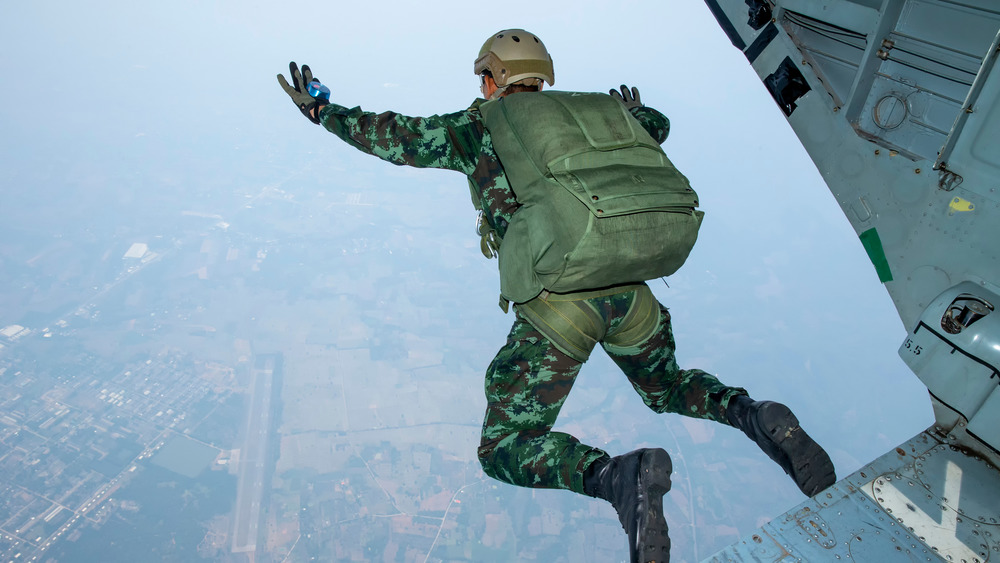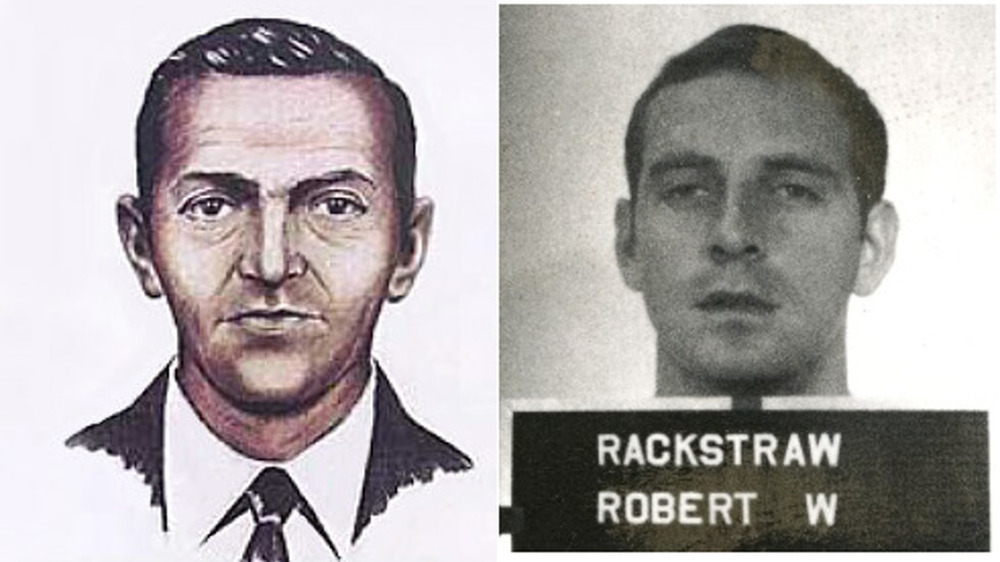The Untold Truth Of The D.B Cooper Plane Hijacking
Fifty years after hijacking a Seattle-bound commercial airplane, D.B Cooper remains a pop culture constant. Part of Cooper's hold on our imagination is the mystery, of course — while there are plenty of theories as to Cooper's true identity, none have been proved conclusively. Part of it is the inherent Hollywood swagger of his caper. Cooper boarded a plane, had a cocktail, announced he had a bomb (and showed a flight attendant a briefcase apparently containing one), and later jumped out of the plane with a parachute and $200,000 strapped to his back. It's the sort of heist you'd expect to see in a movie, not real life. People want to believe Cooper made it, just because cool like that ought to be rewarded.
But the fact is, we don't actually know that much about Cooper. We don't know for sure who he was, we don't know if he survived the jump or if he even knew anything about skydiving, and we don't know what his motivation was, aside from the obvious greed factor. The FBI officially closed their investigation in 2016, and there is no shortage of people who might have been the hijacker, but we can't know for sure.
But that doesn't mean we don't know anything. Cooper interacted with several people during the infamous hijacking, and the decades of investigation turned up a lot of facts. Here's the untold truth of the D.B. Cooper plane hijacking.
He didn't call himself D.B.
Say the name "D.B. Cooper" and everyone knows who you're talking about: Skinny white man wearing a jacket and tie and a pair of cool sunglasses, possibly parachuting into your backyard with a few hundred grand in ransom money.
Except, "D.B." is a mistake. As the FBI notes, he actually gave his name as Dan Cooper. As hard as it might be to believe in 2021, back in 1971 you could literally walk up to a counter in an airport and buy a plane ticket without any identification — as CNN reports, there was almost zero security, so giving a fake name was pretty easy. When the news of the crime started to spread, a journalist mis-heard and used the name "D.B. Cooper," which then went everywhere and became the name everyone used.
The famous sketch of Cooper was created after the plane landed, depicting a man the FBI described as a "white male, 6'1" tall, 170-175 pounds, age-mid-forties, olive complexion, brown eyes, black hair, conventional cut, parted on left." Which narrowed it down to a few million people, give or take. Biography notes that the FBI found a few of Cooper's possessions on the plane, including a clip-on necktie (classy) and his cigarette butts.
It couldn't be done today
As cool as Cooper's hijacking was, it couldn't be repeated today. For one thing, as Vox pointed out in 2016, our response to hijackings changed dramatically after 9/11 and other terrorist attacks. In 1971, the standard wisdom on hijackings was that the criminals wanted to go somewhere, or get money, so the safe thing to do was to go along with their demands. Today, hijackers are treated as dangerous terrorists, and it is assumed they intend to kill everyone on board.
For another, as CNN reports, airport security is so different there is almost no way Cooper could have casually given a false name. And even if he had somehow managed to get a boarding pass under a pseudonym, it would be impossible to bring a briefcase containing what looked like a bomb onto the plane. Even if he had passed a note claiming to have a bomb, the response of the flight crew would have been very, very different today.
Finally, Cooper's exit strategy — jumping out of the rear door of a Boeing 727 — is no longer an option. As Simple Flying relates, the 727's rear door could be opened from inside the plane while it was in flight, and Cooper's success prompted a lot of copycat hijackers who tried the same technique. So in 1972 the Federal Aviation Authority forced Boeing to add a mechanical lock that would prevent the door from being opened in flight. They called the new lock the Cooper Vane.
He probably wasn't an expert
Many amateur sleuths have focused on the fact that Cooper jumped out of the plane with his money, and look for suspects with military training. After all, jumping out of a jet under those conditions – Biography tells us the plane was flying at 10,000 feet, going 200 knots, and was flying through a storm with 200 mile-per-hour winds — isn't something you just decide to do.
This is precisely why most people think Cooper died in the attempt, of course (that, and the $5,800 of the ransom that was found in the wilderness a few years later, according to the FBI's website). But there's reason to believe that Cooper didn't know much about parachuting at all. As New York Magazine notes, Cooper seemed uncertain what kind of parachute he needed, and asked for different kinds. He also selected parachutes that didn't allow him to steer, something an experienced person would have insisted on — not being able to steer your parachute in high winds is how you wind up smashing into things, or trapped in a tree.
Add to that the fact that an experienced jumper would have checked the weather and waited for better conditions, and it's likely that Cooper had little to no experience jumping out of planes at all, and probably died pretty soon after jumping.
We don't know who it was
Every few years an article is published claiming to reveal the true identity of D.B. Cooper. Some of these theories have a lot of adherents, and a lot of compelling (if uncorroborated) evidence. Some are just kind of nuts.
As Vanity Fair reports, new suspects are still being promoted to this day. A woman named Jo Weber claims her husband confessed to being Cooper on his deathbed. A woman named Marla Cooper is certain it was her uncle. Pat and Ron Forman are convinced he was their friend Barbara, who underwent sex reassignment surgery.
And as The Washington Post notes, many people have focused on a man named Robert Rackstraw as a likely suspect. The FBI actually investigated Rackstraw seriously, but eventually eliminated him as a suspect. Rackstraw remains a popular suspect for Internet detectives, but nothing has confirmed him as Cooper, nor any of the other folks who have been floated over the years as possibilities. With the case officially closed and the people directly involved no longer young, it's highly unlikely we'll ever know for sure who Dan Cooper was, or what happened to the $194,200 in ransom money that is still unaccounted for.




